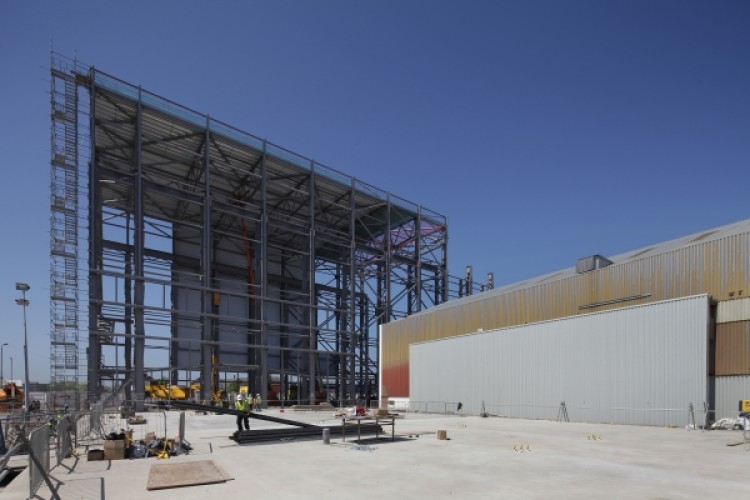At the Northumberland port of Blyth a transformation is taking place that will ensure the UK plays a leading role in accelerating the development of the world’s offshore renewable technology.
The National Renewable Energy Centre (Narec) is investing over £80 million in constructing three on-shore test facilities that will enable the accelerated lifetime testing of wind turbines and blades to develop improved reliability and reduce the financial risks associated with deploying untested -technologies offshore.
The third of these structures, which has attracted investment from the Energy Technologies Institute, will become the world’s largest wind turbine drive train test facility, enabling the testing of turbine nacelles up to 15MW capacity.
Shepherd Construction, the main contractor on all three buildings, had to work closely with the Narec team to come up with a design solution that could accommodate anticipated advances in the offshore technologies.
The building's design, which will incorporate a main testing hall, electro hydraulic rooms and control/monitoring rooms, had to cater for the immense scale of the equipment being tested and the power input that will be required to simulate extreme offshore conditions.
Shepherd Construction first separated a section of an existing test facility and constructed a new gable wall before demolishing part of the existing building and clearing the site to prepare the way for the construction of the new drive train facility.
A precisely-engineered piling solution was designed that would cope with the immense forces that would be imposed on the test bed area, particularly considering the Force Application System (FAS) will weigh 450 tonnes and will be connected to the drive motor using, what is believed to be, the largest articulated coupling in the world.
Once operational, the FAS will impose a maximum load equivalent to 15 diesel locomotives. To withstand this loading, 900mm heavily reinforced piles with a central UC column were installed to a depth of 20 metres, keying into the bedrock below. A monolithic slab construction was then cast requiring 1700m³ of heavily reinforced concrete using four concrete pumps over an 18-hour period.
32-metre high steel frame
Around 1200 tonnes of steel have been used in the 3,000m² frame. The test hall building stands 32-metres high, 72.5 metres long and 26 metres wide with 28 fully fabricated trusses each weighing six tonnes to support the test facility’s roof. The building was also designed with a 20 x 20 metre acoustic overhead door to enable sufficient ease of access for the equipment under-test.
There were two key considerations in the frame’s design. Shepherd Construction’s lead planner Chris Kilcran explains: “Once the test facility is in use, four overhead cranes will be operating, two of which will each be capable of lifting 250 tonnes (500t total) operating on a 21.2 metre span.

“This, together with the fact that the building stands 32 metres high in exposed conditions meant we had to look at a sufficiently robust design that would be capable of handling the loading internally while at the same time countering the force of the wind outside.
“We had to achieve tolerances for the frame of +/-3mm to get the desired result.”
The steel frame is being fabricated and erected by Newton Aycliffe based Finley Structures.
Phil Rose, contracts manager for Finley Structures explains the firm's approach: “One of the technical aspects we took on-board was the incorporation of the main door steelwork into our main frame steelwork which negated the need for site works. For this we had to work to a different type of drawing than we’re normally used to working with which tested the skill of our detailer and close collaboration with the door installer.
“Once we got onto site the biggest challenge was erecting such a high frame in strong winds and so near to the elements of the North Sea.”
Anemometers on MEWPs record wind strength
To tackle this, the team attached anemometers to the MEWP basket to monitor and record the strength of the wind when working at height. The crane was stopped in wind speeds of 21mph or 9m/second and when speeds in excess of 45mph were recorded all work on the steel frame was stopped.
The steelwork has also been fire protected off-site which has shaved around two weeks off the construction programme.
The erection programme has necessitated collaboration with Arup and Red Box Architecture as well as close co-ordination with the follow-on cladding and roofing trades particularly as a fast track construction programme is being employed.
The 15MW drive train test facility is due to complete in 2013 and will be available for commercial testing from next summer.
Project Team
- Client: Narec
- Project Management: Turner & Townsend
- Cost Management: Turner & Townsend
- Main contractor: Shepherd Construction
- Architect: Red Box Design
- Structural Engineer: Arup
- M&E engineer: SES
- CDM Coordinator: Turner & Townsend
- Steel frame: Finley Structures
- Roofing and cladding: Northern Cladding
- Substructure: Heyrod Construction
- Test bed foundations design: IDOM/Merebrook
Got a story? Email news@theconstructionindex.co.uk



